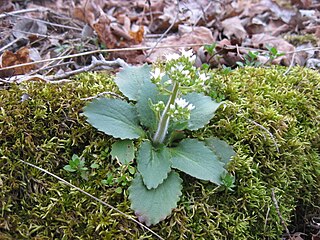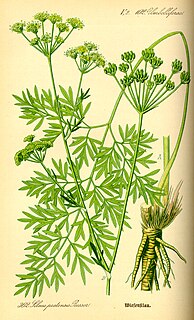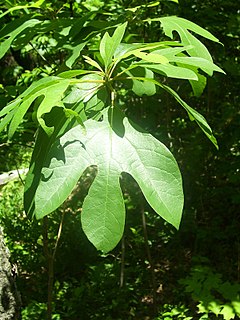
Saxifraga flagellaris, the whiplash saxifrage, is a plant native all over the high arctic and some areas of northern Rocky Mountains, and Norway. It is not very common. It is also known as spider saxifrage or "spider plant", though the latter name more commonly refers to the unrelated Chlorophytum comosum (Agavaceae).

Saxifraga oppositifolia, the purple saxifrage or purple mountain saxifrage, is a species of edible plant that is very common all over the high Arctic and also some high mountainous areas further south, including northern Britain, the Alps and the Rocky Mountains. It is even known to grow on Kaffeklubben Island in north Greenland, at 83°N 40°E, the most northerly plant locality in the world.
There are 164 vascular plant species on the Norwegian Arctic archipelago of Svalbard. This figure does not include algae, mosses, and lichens, which are non-vascular plants. For an island so far north, 164 species constitutes an astonishing variety of plant life. Because of the harsh climate and the short growing season, all the plants are slow growing. They seldom grow higher than 10 cm.

Saxifraga cespitosa, the tufted alpine saxifrage or tufted saxifrage, is a flower common to many arctic heights. It appears further south in mountainous areas of the Alps, Norway, Scotland, Wales, Iceland, Siberia, and western North America.

Saxifraga paniculata is a species of saxifrage native to the United States, Europe and Asia.

Micranthes virginiensis, the early saxifrage, or Virginia saxifrage, is a wildflower native to eastern and central North America.
It is a herbaceous plant, which can reach 30 cm (12 in) tall.

Saxifraga aizoides, yellow mountain saxifrage or yellow saxifrage, is a flowering herb and alpine plant of the genus Saxifraga.

Saxifraga cotyledon, the pyramidal saxifrage, occurs in the mountains of Europe and has rosettes about 20 centimetres (8 in) across of tongue-shaped leaves, beaded but not toothed. In May or June the tall panicles of white flowers, branched and pyramidal in outline, may reach 60 cm (24 in). It is one of Norway's two national flowers. Its relationship to the "silver saxifrages" remains to be resolved to full satisfaction.

Micranthes nivalis is a plant species in the saxifrage family. It is commonly called snow saxifrage or (ambiguously) "alpine saxifrage".

Saxifraga mertensiana, the wood saxifrage or Mertens' saxifrage, is a species of plant in the Saxifragaceae family. It is native to western North America.
Alpine saxifrage is a common name for several different plants and may refer to:

Micranthes micranthidifolia is a member of the Saxifrage family with the common names lettuceleaf saxifrage, branch lettuce and brook lettuce. It grows in wet areas and mountain streams.

Saxifraga cuneifolia, the lesser Londonpride, shield-leaved saxifrage or spoon-leaved saxifrage, is a herbaceous perennial plant belonging to the Saxifragaceae family.

Saxifraga aspera is a species of saxifrage known by the common name of rough saxifrage. In German it is known as Rauhhaariger Steinbrech. It is placed in section Trachyphyllum of the genus Saxifraga. There are two subspecies, Saxifraga aspera subsp. aspera and Saxifraga aspera subsp. micrantha. It is a plant of the pan-Arctic tundra and is also found in Europe at moderately high altitudes in the Alps, Pyrenees and northern Apennines.

Saxifraga bryoides is a species of saxifrage known by the common name of mossy saxifrage. In German it is known as Moosartiger Steinbrech. It is an inhabitant of the Arctic tundra but it also grows in the Alps and other European mountain ranges at high altitudes.

Saxifraga hirculus is a species of saxifrage, commonly called marsh saxifrage, yellow marsh saxifrage, or bog saxifrage. It is a perennial herb with yellow flowers and red stem, 5–30 cm high, found on bog landscape.

Saxifraga globulifera is a flowering plant of the genus Saxifraga and the family Saxifragaceae.

Micranthes is a genus of flowering plants in the saxifrage family. It was formerly included within the genus Saxifraga until recent DNA evidence showed the members of what is now Micranthes are more closely related to Boykinia and Heuchera than to other members of the genus Saxifraga.

The Puy Mary is a summit in the mounts of Cantal in Massif Central in France. It is classified as a "Grand National Site" in France. Nearly 500,000 visitors come to this site every year.






















